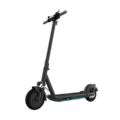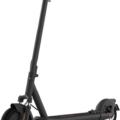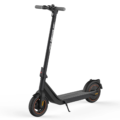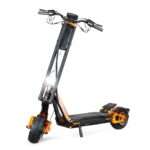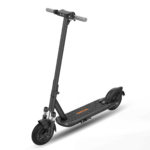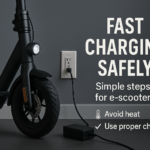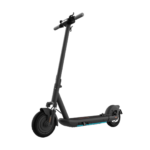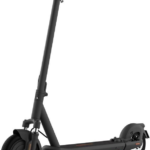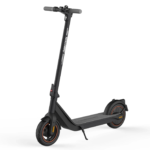- Home
- Scooters
- Electric Scooters
- INMOTION Air
INMOTION Air
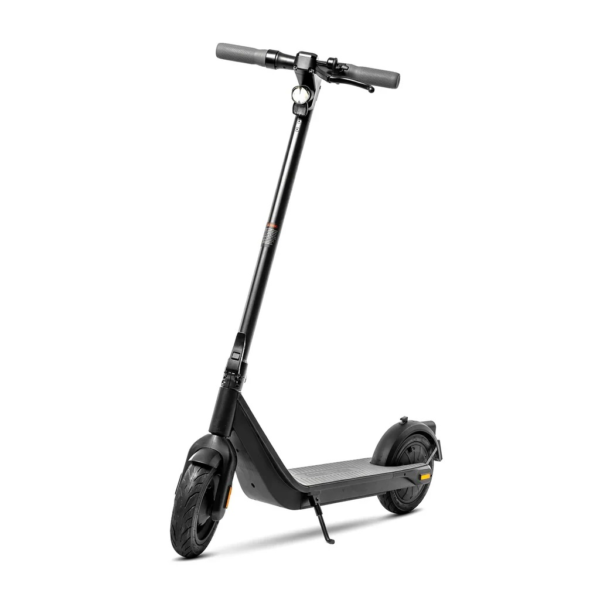

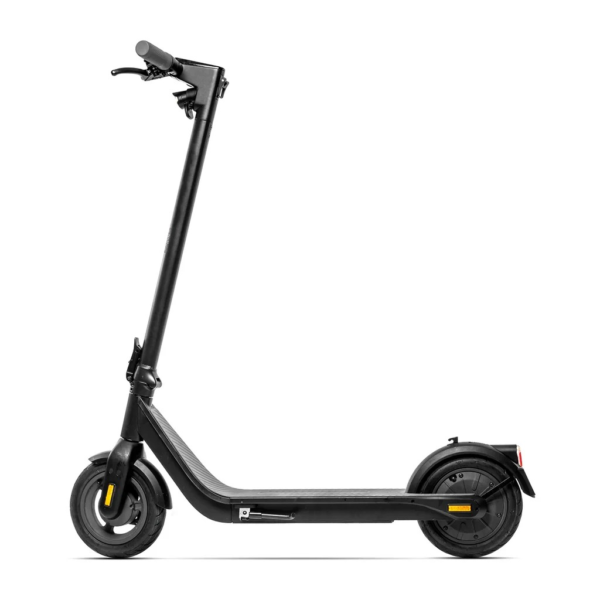
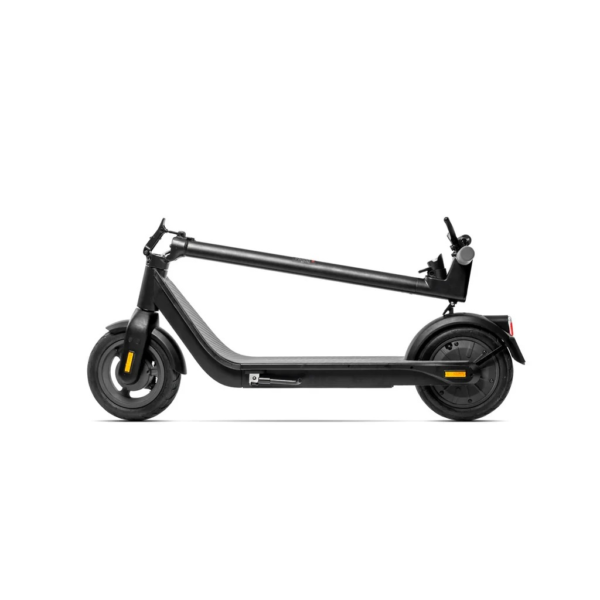
- Battery Range: 22 miles (35 km)
- Top Speed: 18.8 mph (30 km/h)
- Motor Power: 350 W
- Weight Capacity: 264 lb (120 kg)
- Charging Time: ~4.5 h
- Scooter Weight: 34.5 lb (15.6 kg)
PROS
- Lightweight 34.5 lb (15.6 kg)
- 19 mph (30 km/h) top speed
- 22 miles (35 km) range
- Dual braking: drum + regen
- 10″ pneumatic tires
- IP55 water resistance
CONS
- No suspension
- Single 350 W motor limits hills
- Basic lighting. no turn signals
Key Takeaways
- The INMOTION Air is a compact, entry-level commuter scooter ideal for new riders, students, and short urban trips.
- It features a rear hub motor, lightweight aluminum frame, and a simple design emphasizing reliability over high speeds.
- Key specifications include a top speed of 19 mph, a range of 22 miles, and low maintenance with mixed tire types.
- Safety features include a front drum brake with electronic assist, IP55 water resistance, and integrated lights for visibility.
- The scooter is portable and folds easily, making it perfect for multi-modal travel and storage in tight spaces.
Table of contents
- What Is the INMOTION Air?
- How the INMOTION Air Works
- Key Specifications
- Design & Build Quality
- Performance Fundamentals
- Battery, Range & Efficiency
- Ride Quality & Comfort
- Braking & Safety Features
- Portability & Daily Usability
- Maintenance & Care
- Weather & Seasonal Considerations
- INMOTION Air vs Alternatives
- Who the INMOTION Air Is (and Isn’t) For
- FAQs
- Glossary
The INMOTION Air is a compact city scooter built for daily rides. It favors simple controls, light weight, and easy storage. It suits new riders, students, and short commutes. And it slides into tight hallways, trains, and trunks without drama. If you want more pull and a bigger pack from the same family, see the INMOTION Air Pro.
What Is the INMOTION Air?
INMOTION positions the Air as a light, practical city scooter. It uses a rear hub motor and a mixed-tire setup to keep the ride stable and the maintenance low. The frame uses aluminum, the wiring is neatly routed, and the deck has a grippy surface. And you get a clear cockpit with a readable display and a single brake lever. This overview focuses on the core specifications and day-to-day behavior.
The Air’s feature list focuses on fundamentals. You get front and rear lights, a drum front brake with electronic braking on the rear, and app support for basic settings. So you can set it up fast and keep the routine simple. The package works best for riders who value reliability over flash.
How the INMOTION Air Works
Think of the system as four parts that talk to each other. The battery feeds the controller, the controller drives the rear hub motor, and the throttle and brake tell the controller what to do. Then the display shows speed and battery level.
Motor and controller. A rear hub motor turns electrical power into motion with smooth, linear push. The controller meters current like a dimmer switch. So low throttle gives gentle pull from a standstill, and more throttle adds torque for ramps and climbs.
Battery and BMS. A lithium-ion pack stores energy for the ride. And a built-in battery management system balances cells and guards against over-charge and over-discharge. Then the 42V, 2A charger tops it off between rides.
Throttle. A simple throttle on the bar tells the controller how much power to send. Small inputs help in crowded paths. Larger inputs help clear intersections and short hills.
Brakes and regen. A front drum brake adds steady, predictable bite. The rear motor adds electronic braking that feeds a bit of energy back into the pack. So lever feel starts soft, then firms up as speed drops.
Key Specifications
Below is a concise, US-first view with metric in parentheses.
General
| Item | Value |
|---|---|
| Model | INMOTION Air |
| Intended use | Urban commuting, short trips |
| Max rider weight | 264 lb (120 kg) |
| Warranty | 12 months (limited) |
Performance & Power
| Item | Value |
|---|---|
| Top speed | 19 mph (30 km/h). Some regions limit to 15.5 mph (25 km/h) |
| Rated motor power | 350 W rear hub |
| Peak motor power | 720 W |
| Climb angle | 18% grades (short ramps and hills) |
Battery, Charging & Electrical
| Item | Value |
|---|---|
| Battery chemistry | 18650 lithium-ion |
| Battery capacity | 270 Wh |
| Charger | 42V DC, 2A |
| Charge time | ~4.5 hours |
| App connectivity | Bluetooth, basic settings, activation |
Build & Dimensions
| Item | Value |
|---|---|
| Frame | Aluminum alloy |
| Tires | Front 10″ pneumatic. Rear 10″ foam-filled |
| Net weight | 34.5 lb (15.6 kg) |
| Dimensions (unfolded) | 44.4 x 17.5 x 47.2 in (112.8 x 44.5 x 120.0 cm) |
| Dimensions (folded) | 44.4 x 17.5 x 20.5 in (112.8 x 44.5 x 52.1 cm) |
| Fold mechanism | Single-latch, stem fold |
Safety & Control
| Item | Value |
|---|---|
| Brakes | Front drum + rear electronic braking |
| Lights | Front headlight and rear light |
| IP rating (body) | IP55 |
| Reflectors | Front and rear reflectors |
Features & Extras
| Item | Value |
|---|---|
| Display | Speed, battery, mode, icons |
| Riding modes | ECO, Drive, Sport |
| Cruise Control | Yes. Holds speed after a steady throttle |
| Kickstand | Side stand |
Warranty & Compliance
| Item | Value |
|---|---|
| Warranty term | 12 months (limited) |
| Notes | Local rules and speed caps vary |
Design & Build Quality
The frame feels solid for its class, and the finish resists scuffs from daily use. The deck uses a textured, non-slip layer that grips well with sneakers. And the wiring sits inside the frame, so there are no loose loops to snag on bags or clothes.
The cockpit keeps controls tight and readable. The display shows speed and battery at a glance. Then the single brake lever simplifies handwork. And the bell sits within reach for quick signals.
Tires shape the ride here. The front uses a pneumatic tire that softens cracks and seams. The rear uses foam fill to cut puncture risk and reduce tube swaps. So you still get some give up front with low upkeep at the back.
Fit-and-finish is tidy for a scooter at this weight. Panel gaps stay even. Fasteners sit flush. And the latch locks with a clear, repeatable motion you can trust after a week of rides. Within the weight and dimensions specifications, the Air feels well sorted.
Performance Fundamentals
Starts and pace. The Air pulls away in a predictable way that helps new riders. Low throttle gives steady roll without a jump. And full throttle adds enough drive for short sprints between lights on flat ground.
Cruising stability. The 10-inch tires track straight on smooth asphalt. And the low deck keeps weight close to the ground. So small steering changes settle quickly. Then the stem stays stable through typical city speeds.
Hills. The brand rates the Air for slopes near 18%. On 7–10% urban hills, you should expect a drop in speed, yet the scooter keeps moving if you carry some entry speed. And rider weight and headwinds change the feel. So plan to shift your stance slightly forward and hold a steady line.
Heat management. The controller meters current to protect the pack and motor. So if you push hard for long blocks, you may feel a softer pull after a stretch. Then power returns as speed and load drop.
Battery, Range & Efficiency
The rated range is 22 miles (about 35 km) in gentle use. Real-world range depends on rider weight, topography, temperature, average speed, and stop-and-go time. And most owners see shorter numbers than the lab. So plan your routes with a cushion.
Rider and route. A lighter rider on flat bike paths at a steady pace gets the best distance. But frequent climbs, rough pavement, and hard starts cut range. And cold weather reduces output, then the pack warms up and performance improves a bit during the ride.
Charging habits. The included 42V, 2A charger fills the pack in about 4.5 hours. Charge in a dry, ventilated place, and close the charge-port cap after you unplug. Do not charge when the scooter or charger is wet. Keep the pack away from high heat and severe cold.
Efficiency tips. Keep speeds smooth instead of constant bursts. Use ECO or Drive for longer rides. And check tire pressure weekly to keep rolling resistance in check.
Ride Quality & Comfort
You feel the mixed-tire setup most on broken city pavement. The front pneumatic tire absorbs small edges from expansion joints and pavers. The rear foam-filled tire rides firmer but shrugs off punctures from glass slivers and staples. So the ride is balanced for everyday routes.
There is no suspension, and that keeps weight down. On smooth asphalt the deck feels composed and quiet. On cracked concrete you will hear more tire noise, and you will want to bend knees and ride with a bit of flex. The stem has a modest, normal amount of flex under hard braking or rough patches. So the chassis still tracks straight.
Handlebar height fits a broad range of riders. The grips feel basic but do not slip. And the deck length gives enough room to switch from a parallel stance to a diagonal stance for longer rides.
The headlight covers a short cone ahead of the wheel for city speeds. The tail light stays visible to cars at dusk. For late rides, add a handlebar light or a helmet light to see farther. That improves reaction time on dark paths.
Braking & Safety Features
The front drum brake delivers stable, rain-tolerant stopping with low maintenance. The rear motor adds electronic braking as you squeeze the lever, and it ramps down as speed falls. So the lever feel starts soft and firms up near walking pace.
Lights and reflectors improve visibility. The IP55 body rating covers daily splash and light rain, not submersion or deep puddles. Plan to slow down on wet metal grates and painted lines. Then check the brake response after any wet ride.
The single brake lever layout suits beginners. You learn one motion for every stop. And the drum design keeps brake pads enclosed from grit, which helps over time.
Portability & Daily Usability
At about 34.5 pounds (15.6 kg), the INMOTION Air carries up stairs without strain for most adults. The fold uses a single latch, and the stem locks down in one motion when you learn the feel. The folded shape is compact, with the bar staying within the deck footprint.
The deck sits low, so foot-off stops feel natural. The kickstand holds the scooter at a stable angle on flat ground. For storage, pick a dry spot and keep the charger nearby. Then lock with a sturdy U-lock or a chain through a fixed object if you leave it in a shared area. Do not rely on the latch alone for security.
For multi-modal trips, the folded length fits across the floor of most rail cars or hatchbacks. The weight is easy to manage at train doors. So short hops and transfers work well.
Maintenance & Care
A simple schedule keeps the Air riding well.
Before each ride. Check tire condition and pressure. Squeeze the brake lever to confirm firm feel. Look for any loose fasteners by feel and by sight along the stem latch, axle nuts, and handlebar hardware.
Weekly. Top up front tire pressure. Wipe the deck and stem with a damp cloth. Check headlight and tail light.
Monthly. Open the app and look for firmware updates. Inspect the front drum cable for smooth pull and clean the front wheel area. Look over reflectors for secure mounting.
Charging. Charge in a dry, cool place. Plug the 42V, 2A charger into the wall first, then the scooter. Unplug after the indicator turns green. Do not charge when wet, and do not store in high heat or severe cold. Pick an indoor spot and keep the charge-port cap closed after use.
Storage. If you store it for weeks, leave the battery around mid-level. Top up monthly. Avoid direct sun and hot car interiors. Keep it off moist floors.
Weather & Seasonal Considerations
Light rain rides fall under the IP55 splash rating, but puddles and streams do not. Slow down on wet surfaces and give yourself more room to stop. Dry the scooter after you get home.
Cold weather cuts range and power. So plan shorter routes when temperatures drop. Warm the pack indoors before you ride for more stable output. Heat is tough on cells. Then park in shade during summer rides.
Traction changes with temperature and surface. On smooth concrete, a bit less speed and a bit more room help. Keep the front tire at proper pressure for the best grip and shock filtering.
INMOTION Air vs Alternatives
Against basic last-mile scooters. The Air rides more stable than tiny-wheel last-mile models. You get a stronger hill start, better lights, and a sturdier latch. The drum plus electronic brake combo is a clear upgrade for consistent stops.
Commuters with larger batteries. Mid-range models add energy and often stop harder with bigger brake parts. They can weigh 40–55 lb and stretch distance by 10–20 miles. Even so, they feel bulky on stairs and at the office. The Air wins on grab-and-go. For longer routes in the same lineup, the INMOTION S1 brings a larger pack and more range, though it is heavier.
Against performance class. Sport models hit higher speeds and carry stiffer frames and dual brakes. They cost more and weigh more. Their ride feels firm on rough pavement. The Air is easier to live with for short city hops.
Against off-road or dual-motor rigs. Those aim at trails and steep climbs. They add suspension, longer decks, and heavy tires. They are not friendly for transit or small apartments. The Air stays true to small-space city life. On paper specifications differ a lot, but the Air keeps the focus on portability.
Who the INMOTION Air Is (and Isn’t) For
Great for:
- Students and first-time riders who want a simple setup.
- Short commutes under 6–8 miles each way on mostly flat routes.
- Multi-modal travel where weight and folded size matter.
- Riders who want low-maintenance tires and a tidy, cable-clean frame.
Not ideal for:
- Long suburban rides that need bigger batteries.
- Very steep neighborhoods with extended climbs.
- Riders who want suspension or high top speed.
- Heavy cargo or frequent two-bag grocery runs.
FAQs
How fast does the INMOTION Air go?
The Air reaches about 19 mph on open ground in markets without a lower cap. Some regions cap speed at 15.5 mph.
What is the real-world range?
Plan for less than the rated 22 miles. Rider weight, hills, wind, and cold weather reduce distance.
Does it have Cruise Control?
Yes. Hold a steady speed for a bit and the scooter maintains that speed until you brake or change throttle.
Can I ride the INMOTION Air in the rain?
Light rain rides are covered by an IP55 body rating. Avoid deep puddles and flooding.
What tire type does it use?
Front 10-inch pneumatic for comfort. Rear 10-inch foam-filled for low puncture risk.
How does the brake feel at the lever?
The front drum gives steady bite, and rear electronic braking adds gentle decel. The feel firms up as speed drops.
Where can I find an “INMOTION Air overview” in one place?
You are reading it. This guide brings specifications, setup tips, and riding advice together.
Glossary
Ah (amp-hour). A measure of how much charge a battery can hold.
Wh (watt-hour). Battery energy. Multiply voltage by amp-hours.
BMS. Battery management system that guards the pack and balances cells.
Controller. The board that meters current to the motor.
Regen. Electronic braking that feeds a small amount of energy back into the pack.
Drum brake. Enclosed brake with good wet performance and low upkeep.
Hub motor. Motor built into the wheel hub.
Stem flex. Small, normal bending of the stem under load.
IP rating. Ingress protection scale for dust and water. IP55 covers splash.
Grade. Hill steepness shown as a percent rise over run.
Pedestrian mode. Low-speed mode for walking paths or crowded areas.
Cruise Control. System that holds set speed after steady throttle.
Pneumatic tire. Air-filled tire that smooths bumps.
Foam-filled tire. Solid-core tire that resists punctures.
Peak power. Short burst output higher than rated power.
The INMOTION Air is a compact city scooter built for daily rides. It favors simple controls, light weight, and easy storage. It suits new riders, students, and short commutes. And it slides into tight hallways, trains, and trunks without drama.
What Is the INMOTION Air?
The INMOTION Air is a light commuter with tidy design and practical parts. It uses a rear hub motor, a sturdy aluminum frame, and clean internal routing. The deck has good grip. And the cockpit keeps things clear with a bright display and a single brake lever.
You get the basics you need every day. There is a front headlight, a tail light, and reflectors. There is a front drum brake plus electronic braking on the rear wheel. So you set it up fast. Then you just ride.
It trades peak speed for control, reliability, and low upkeep. For crowded paths and tight streets, that trade works. And for most short trips, it feels calm and predictable.
How the INMOTION Air Works
Think of four core parts that talk to each other. The battery stores energy. The controller meters power. The motor turns that power into motion. Then the throttle and brake tell the system what to do.
Motor and controller. A rear hub motor pushes with smooth, steady pull. The controller acts like a dimmer that feeds current in clean steps. So a light press rolls you away without a jump. Then a deeper press adds torque for ramps and short hills.
Battery and BMS. A lithium-ion pack holds energy for your route. A battery management system balances cells and guards the pack during charge and discharge. The 42V, 2A charger tops it up between rides. So most owners plug in after work and roll out fresh the next morning.
Throttle. A thumb throttle sets power. Small inputs help you weave through crowds. Bigger inputs help you clear intersections. And steady input makes for smooth cruising.
Brakes and regen. A front drum brake provides firm, repeatable bite. The rear motor adds electronic braking as you squeeze the lever. So the stop starts gentle and firms up near walking speed. Then the scooter settles without a jerk.
Key Specifications
Below is a US-first view with metric in parentheses. This table groups the most useful details.
General
| Item | Value |
|---|---|
| Model | INMOTION Air |
| Intended use | Urban commuting, short trips |
| Max rider weight | 264 lb (120 kg) |
| Warranty | 12 months (limited) |
Performance & Power
| Item | Value |
|---|---|
| Top speed | 19 mph (30 km/h). Some regions cap at 15.5 mph (25 km/h) |
| Rated motor power | 350 W rear hub |
| Peak motor power | 720 W |
| Climb angle | Up to 18% on short ramps |
Battery, Charging & Electrical
| Item | Value |
|---|---|
| Chemistry | 18650 lithium-ion |
| Capacity | 270 Wh |
| Charger | 42V DC, 2A |
| Charge time | ~4.5 hours |
| App connectivity | Bluetooth for basic settings and activation |
Build & Dimensions
| Item | Value |
|---|---|
| Frame | Aluminum alloy |
| Tires | Front 10″ pneumatic. Rear 10″ foam-filled |
| Net weight | 34.5 lb (15.6 kg) |
| Dimensions (unfolded) | 44.4 × 17.5 × 47.2 in (112.8 × 44.5 × 120.0 cm) |
| Dimensions (folded) | 44.4 × 17.5 × 20.5 in (112.8 × 44.5 × 52.1 cm) |
| Fold mechanism | Single-latch stem fold |
Safety & Control
| Item | Value |
|---|---|
| Brakes | Front drum + rear electronic braking |
| Lights | Front headlight and rear light |
| IP rating (body) | IP55 |
| Reflectors | Front and rear reflectors |
Features & Extras
| Item | Value |
|---|---|
| Display | Speed, battery, mode, icons |
| Riding modes | ECO, Drive, Sport |
| Cruise Control | Yes. Holds speed after steady throttle |
| Kickstand | Side stand |
Warranty & Compliance
| Item | Value |
|---|---|
| Warranty term | 12 months (limited) |
| Notes | Local rules and speed caps vary |
Design & Build Quality
The Air feels solid for its weight. The finish resists scuffs. And the deck texture grips well with sneakers in dry weather. So starts and stops feel planted.
The cockpit is clean. The display reads at a glance. The single brake lever keeps hand work simple, which helps new riders. A bell sits within easy reach for quick signals. Then the throttle position supports fine control at low speed.
Tires set the character. The front pneumatic tire softens small cracks and seams. The rear foam-filled tire trades some cushion for fewer flats. So the ride has a touch of give up front and low upkeep in back. For city blocks, that balance makes sense.
Panels line up well. Fasteners sit flush. And the fold latch locks with a crisp click you can feel. After a week of rides, the hinge stays straight. So the frame keeps its alignment in daily use.
Performance Fundamentals
Starts and pace. The INMOTION Air leaves the line in a smooth, steady way. A light press gives gentle roll without a jump. A firm press adds drive for short sprints between lights. So the scooter feels calm rather than twitchy.
Cruising stability. The 10-inch tires track straight on clean asphalt. The low deck keeps weight near the ground. And small steering inputs settle fast. So bars stay steady at typical city speeds.
Hills. Short slopes near 18% are within reach. On 7–10% grades, expect some speed drop. Even so, the scooter keeps moving if you carry a bit of entry speed and hold a straight line. Rider weight and wind matter here. So plan your approach and keep the throttle smooth.
Heat behavior. The controller trims current if you push hard for a while. So pull may soften on long, full-throttle stretches. Then power comes back as load drops. For daily rides, this feels normal.
Battery, Range & Efficiency
The rated range is about 22 miles (35 km) under gentle use. Real numbers vary with rider weight, terrain, temperature, average speed, and stop-and-go time. Many owners see less than the lab figure. So plan routes with a margin.
Rider and route. A lighter rider on flat bike paths at steady pace gets the most distance. Frequent hills, rough surfaces, and hard launches eat range. Cold days trim output as well. Then the pack warms while you ride and performance steadies a bit.
Charging habits. The 42V, 2A charger takes about 4.5 hours from low. Charge in a dry, ventilated place. Close the port cap after you unplug. And avoid charging when the scooter or charger is wet. Keep the scooter away from high heat or severe cold during charge. So pick an indoor spot and make it routine.
Efficiency tips. Smooth speed saves energy. ECO or Drive stretches distance on longer routes. Proper front tire pressure cuts rolling loss. And gentler starts save more than you think.
Ride Quality & Comfort
The mixed-tire setup shapes the feel. The front air tire absorbs small edges from expansion joints and pavers. The rear foam-filled tire rides firmer but shrugs off tiny debris. So the ride stays composed on most city streets.
There is no suspension. That choice keeps weight down and folding simple. On smooth asphalt the deck feels quiet and sure. On cracked concrete you will hear more tire noise. Then you can bend your knees and add a little body flex to smooth things out. The stem shows a modest, normal bit of flex under hard braking. So the chassis still tracks straight.
The bar height suits a wide range. The grips are basic yet secure. And the deck length lets you switch from a parallel stance to a diagonal stance for longer rides. If you ride at dusk, the headlight covers a short cone ahead of the wheel. The tail light stays visible to cars. For late trips, a bar-mounted or helmet light helps you see farther. So your reaction time improves on dark paths.
Braking & Safety Features
The front drum brake gives steady, rain-tolerant stopping. The rear motor adds electronic braking as you squeeze the lever. And the system eases off as speed falls, which avoids a harsh stop. So the lever feel starts soft and firms up near walking pace.
Lights and reflectors boost visibility in mixed traffic. The IP55 body rating covers splash and light rain, not deep puddles. So slow down on wet paint and metal grates. Then check lever feel after a wet ride to confirm normal bite.
The single-lever layout helps beginners. You learn one motion for every stop. And the drum’s enclosed parts resist grit and dust, which reduces upkeep over time.
Portability & Daily Usability
At about 34.5 lb (15.6 kg), the INMOTION Air is manageable on stairs. The fold uses a single latch. The stem locks down in one motion once you learn the rhythm. And the folded shape stays compact, with the bar within the deck footprint. So apartment storage and small trunks are easy.
The deck sits low, which helps steady foot-off stops. The kickstand holds the scooter at a stable angle. For storage, pick a dry spot near an outlet. Then use a U-lock or stout chain if you park in shared spaces. Do not rely on the fold latch for security.
For transit, the folded length fits across most rail car floors. The weight is easy to manage at train doors. And short transfers feel smooth. So mixing scooter and bus or train becomes a workable habit.
Maintenance & Care
A short checklist keeps the Air riding well. It takes only a few minutes.
Before each ride. Check tire condition and pressure. Squeeze the brake lever to confirm firm feel. Look over the stem latch, axle nuts, and handlebar hardware for anything loose. Then test the lights.
Weekly. Top up front tire pressure. Wipe the deck and stem with a damp cloth. Check the bell and reflectors.
Monthly. Open the app and check for firmware updates. Inspect the front drum cable for smooth pull. Clean around the front wheel for grit. Then confirm the fold latch closes with a crisp click.
Charging. Charge in a dry, cool place. Plug the charger into the wall first, then the scooter. Unplug after the indicator turns green. Do not charge when wet. And do not store in high heat or severe cold. So keep the port cap closed between charges.
Storage. If it sits for weeks, leave the battery near mid-level. Top it up monthly. Keep it out of direct sun. And avoid hot car interiors. A small mat lifts the deck away from damp floors.
Weather & Seasonal Considerations
Light rain rides fall within the IP55 rating. Puddles and streams do not. So ease your speed on wet surfaces and leave extra room to stop. Then dry the scooter after you get home.
Cold cuts range and power. Plan shorter routes when temps drop. Warm the pack indoors before you ride for steadier output. Heat stresses cells as well. So park in shade during summer rides and let the scooter cool before charging.
Traction changes with both temperature and surface. On smooth concrete, trim speed and give yourself space. Proper front tire pressure helps grip and comfort. And clear mud from the tread if you hit a wet patch.
INMOTION Air vs Alternatives
Tiny last-mile models. The Air feels more stable than very small-wheel scooters. You get stronger starts on hills, better lights, and a sturdier latch. So short hops feel calmer and safer.
Commuters with larger batteries. Mid-range models add energy and often stop harder with bigger brake parts. They can weigh 40–55 lb and stretch distance by 10–20 miles. Even so, they feel bulky on stairs and at the office. The Air wins on grab-and-go.
Performance class. Sport models hit higher speeds with stiff frames and dual brakes. They cost more and weigh more. And the ride can feel firm on rough pavement. For short city trips, the Air is easier to live with.
Off-road or dual-motor rigs. Those target trails and steep climbs. They add suspension, longer decks, and heavy tires. So they do not fit transit or small apartments well. The Air stays true to small-space city life and keeps its focus on portability over brute force.
Who the INMOTION Air Is (and Isn’t) For
Great for:
- Students and first-time riders who want a simple setup.
- Short commutes under 6–8 miles each way on mostly flat routes.
- Multi-modal travel where weight and folded size matter.
- Riders who want modest upkeep and a clean, cable-light frame.
Not ideal for:
- Long suburban rides that need larger batteries.
- Very steep neighborhoods with extended climbs.
- Riders who want suspension or high top speed.
- Heavy cargo days or frequent two-bag grocery runs.
So the INMOTION Air works as a calm, practical tool for compact city travel. It does not chase the highest speed. And it does not pile on heavy parts. Instead, it stays light, tidy, and predictable.
FAQs
How fast does the INMOTION Air go?
It reaches about 19 mph in markets without lower caps. Some regions set a 15.5 mph limit.
What is the real-world range?
Plan for less than the rated 22 miles. Rider weight, hills, wind, and cold trim distance.
Does it have Cruise Control?
Yes. Hold a steady speed for a short stretch and the scooter keeps that pace until you brake or change throttle.
Can I ride the INMOTION Air in the rain?
Light rain is fine within an IP55 rating. Avoid deep puddles. Then dry the scooter after you get home.
What tire type does it use?
Front 10-inch pneumatic for comfort. Rear 10-inch foam-filled for puncture resistance. So daily upkeep stays light.
How does the brake feel at the lever?
The front drum gives steady bite. The rear electronic braking adds gentle decel. And the feel firms up as speed drops.
Where can I find an “INMOTION Air overview” in one place?
You are reading it now. This single guide packs the key specs, setup tips, and riding advice.
Glossary
Ah (amp-hour). Battery charge capacity.
Wh (watt-hour). Battery energy. Voltage times amp-hours.
BMS. Battery management system that guards and balances cells.
Controller. The board that meters current to the motor.
Regen. Electronic braking that feeds a small amount of energy back into the pack.
Drum brake. Enclosed brake with good wet performance and low upkeep.
Hub motor. Motor built into the wheel hub.
Stem flex. Small, normal bending of the stem under load.
IP rating. Dust and water ingress scale. IP55 covers splash.
Grade. Hill steepness shown as percent rise over run.
Pedestrian mode. Low-speed mode for crowded paths.
Cruise Control. System that holds speed after steady throttle.
Pneumatic tire. Air-filled tire that smooths small bumps.
Foam-filled tire. Solid-core tire that resists punctures.
Peak power. Short burst output above rated power.
Specifications
General
| Model The Model specifies the exact version or name of the scooter. It helps identify its unique design, features, and specifications within the manufacturer’s product line. Knowing the model makes it easier to compare options, find compatible accessories, or look up support information. | Air |
| Brand The Brand identifies the manufacturer or company that designs and produces the scooter. A trusted brand is a sign of quality, reliability, and good customer support. Well-known brands often have higher standards for safety, performance, and after-sales service, giving you more confidence in your purchase. | INMOTION |
| Release Date The Release Date indicates when the scooter model was officially launched on the market. This helps you know how current the design, technology, and features are. A newer release date often means updated components, improved performance, and the latest safety or smart features. | 18 November 2025 |
| Recommended Age Recommended Age indicates the minimum age range that the scooter is designed for, based on safety, size, and ease of use. Following the recommended age helps ensure that riders can handle the scooter’s speed, weight, and controls comfortably and safely. Always check local laws and use protective gear, especially for younger riders. | +16 |
Performance & Power
| Motor Power (Wattage) What it means: The motor power, measured in watts (W), shows how strong the scooter’s electric motor is. Why it matters: Higher wattage usually means better acceleration, more torque, and improved performance on hills or rough terrain. For example, a 250W motor is good for flat city roads and light riders, while a 500W or 1000W motor provides more power for faster speeds or climbing steep inclines. | 350 W rear hub |
| Top Speed The Top Speed indicates the maximum speed that the scooter can reach under optimal conditions. It’s usually measured on level ground with a fully charged battery and an average rider weight. A higher top speed allows you to travel longer distances faster, but always ensure you ride within legal speed limits and your personal comfort zone for safety. | 18.8 mph (30 km/h) (EU limited to 15.5 mph/25 km/h) |
| Battery Capacity Battery Capacity refers to the total amount of energy the scooter’s battery can store, usually measured in ampere-hours (Ah) or watt-hours (Wh). A higher battery capacity means you can ride longer distances on a single charge, reducing the need for frequent recharging. Keep in mind that actual range can vary depending on rider weight, terrain, speed, and weather conditions. | 36 V 7.8 Ah (280 Wh) |
| Estimated Range per Charge The Estimated Range per Charge indicates the average distance the scooter can travel on a single full battery charge. This range is calculated under optimal conditions, such as flat terrain, moderate speed, and average rider weight. Real-world range may vary depending on riding style, terrain, weather, and load. A longer range means fewer recharges and greater freedom for longer trips. | 22 miles (35 km) |
| Hill Climb Ability Hill Climb Ability describes the maximum incline or slope that the scooter can handle while maintaining stable performance. It’s typically expressed as a percentage or in degrees. A higher hill climb rating means the scooter can tackle steeper hills without losing too much speed or power. Actual climbing performance may vary based on rider weight, battery charge, and terrain conditions. | 18% |
| Drive System The Drive System refers to how power from the motor is delivered to the wheels. Electric scooters typically use either a hub motor (directly integrated into the wheel) or a chain/belt drive system. A high-quality drive system ensures smooth acceleration, efficient power transfer, and low maintenance. The choice of drive system affects performance, noise level, and overall ride experience. | Rear hub (RWD) |
Charging & Electrical
| Charging Time Charging Time indicates how long it takes to fully recharge the scooter’s battery from empty to 100% using the standard charger provided. Faster charging means less downtime and more time on the road. Actual charging time may vary slightly depending on battery capacity, charger output, and environmental conditions. | ~4.5 h |
| Battery Type Battery Type refers to the specific technology used in the scooter’s battery, which affects performance, lifespan, weight, and charging time. Most modern electric scooters use high-quality lithium-ion (Li-ion) batteries because they offer a good balance of energy density, durability, and low maintenance. A reliable battery type ensures consistent power delivery and longer riding ranges. | Lithium-ion pack with Smart BMS |
| Removable Battery A Removable Battery means the battery pack can be easily detached from the scooter for convenient charging and replacement. This feature allows you to charge the battery separately, swap it with a spare for extended range, or securely store it indoors in extreme weather. Removable batteries add flexibility and make it easier to keep your scooter powered up wherever you are. | Non-removable internal battery (fixed pack) |
| Regenerative Braking Regenerative Braking is an energy-saving feature that converts some of the energy normally lost during braking back into battery power. When you slow down or brake, the motor works in reverse to generate electricity, which helps extend the scooter’s range and improves overall efficiency. This system also reduces wear on traditional brake components, leading to lower maintenance over time. | Yes (via electronic brake) |
| Lighting Lighting refers to the built-in front and rear lights that enhance visibility and safety when riding in low-light conditions or at night. Good lighting helps you see the road ahead and ensures that other road users can see you. Many scooters include LED headlights, taillights, and sometimes brake lights or side reflectors for added safety and compliance with local traffic regulations. | LED headlight + rear LED/brake + reflectors |
Build & Dimensions
| Scooter Weight Scooter Weight refers to the total weight of the scooter when fully assembled, including the battery. This affects how easy it is to carry, lift, and store the scooter when not in use. A lighter scooter is more portable and convenient for commuting, especially if you need to carry it upstairs or onto public transport. Keep in mind that a sturdy frame and quality components may add to the weight but also contribute to better durability and ride stability. | 34.5 lb (15.6 kg) |
| Maximum Rider Weight Maximum Rider Weight indicates the highest rider weight that the scooter is designed to safely support while maintaining optimal performance and stability. Staying within this limit helps ensure reliable acceleration, braking, and climbing ability, and it protects the frame, suspension, and motor from excessive strain. Exceeding the recommended limit may reduce performance and increase wear on components. | 264 lb (120 kg) |
| Deck Size Deck Size refers to the dimensions of the scooter’s standing platform. A wider and longer deck provides more foot space, allowing you to stand comfortably and adjust your stance while riding. A well-sized deck improves balance and stability, especially on longer rides or at higher speeds. Compact decks, on the other hand, help keep the scooter lightweight and portable. | Low deck; compact commuter geometry |
| Handlebar Height Handlebar Height refers to the distance from the deck to the handlebars, which affects your riding posture and comfort. An appropriate handlebar height helps you maintain good balance, reduces strain on your back and arms, and makes steering more comfortable. Some scooters have adjustable handlebars to fit riders of different heights, while others have a fixed height for a streamlined design. | Fixed |
| Folding Mechanism The Folding Mechanism describes how easily and securely the scooter can be folded for carrying and storage. A well-designed folding system lets you quickly collapse the scooter into a compact size, making it convenient to transport on public transit, store under a desk, or fit into a car trunk. Look for sturdy latches and safety locks to ensure the scooter stays firmly in place when folded or unfolded. | 2-step quick fold |
| Dimensions Folded Dimensions indicate the size of the scooter when it’s fully folded. This measurement shows how much space the scooter will take up when stored or carried, making it easier to check if it will fit in your car trunk, under a desk, or in a closet. Compact folded dimensions are ideal for commuters who need to bring their scooter on public transport or store it in tight spaces. | Unfolded: 44.4 × 17.5 × 47.2 in (1125 × 445 × 1200 mm); Folded: 44.4 × 17.5 × 20.5 in (1125 × 445 × 520 mm) |
| Material Material refers to the primary construction materials used for the scooter’s frame and key components. High-quality materials like aircraft-grade aluminum, reinforced steel, or durable composites provide strength, stability, and a lighter overall weight. A sturdy material ensures the scooter can handle daily wear and tear while maintaining safety and performance. | Aluminum alloy |
Safety & Control
| Brake Type(s) Brake Type(s) describe the braking systems the scooter uses to help you slow down or stop safely. Common brake types include mechanical brakes (like drum or disc brakes), electronic brakes, and foot brakes. Many scooters combine multiple braking systems for added safety and shorter stopping distances. The type and quality of brakes affect your control, especially when riding at higher speeds or on slopes. | Front drum + rear electronic (regen) |
| Suspension Suspension refers to the system that absorbs shocks and vibrations while riding, providing a smoother and more comfortable ride over uneven or rough surfaces. Scooters may have front suspension, rear suspension, or dual suspension for better shock absorption and stability. Good suspension helps reduce rider fatigue and improves control, especially when riding on bumpy roads or off-road paths. | None |
| Tire Type Tire Type refers to the kind of tires the scooter uses, which directly affects ride comfort, traction, and maintenance. Common types include solid (airless) tires, pneumatic (air-filled) tires, or hybrid options. Pneumatic tires offer better shock absorption and a smoother ride on rough surfaces, while solid tires are puncture-proof and require less upkeep. The right tire type helps ensure safe handling and a comfortable ride in different conditions. | 10″ pneumatic tires |
| Tire Size Tire Size indicates the diameter and width of the scooter’s tires, which affect ride comfort, stability, and how well the scooter handles different terrains. Larger tires generally offer better shock absorption and a smoother ride over bumps and rough surfaces, while smaller tires keep the scooter lighter and more portable. Choosing the right tire size helps ensure a balance between agility and comfort. | 10-inch |
| Kickstand The Kickstand is a built-in stand that allows you to park your scooter upright when it’s not in use. A sturdy kickstand keeps the scooter stable and prevents it from tipping over, protecting it from scratches and damage. It also makes storing and accessing your scooter more convenient, whether you’re at home, work, or on the go. | Side kickstand |
| Water Resistance Rating Water Resistance Rating indicates how well the scooter is protected against water and moisture, usually shown as an IP (Ingress Protection) rating. This rating helps you understand whether the scooter can handle light rain, splashes, or wet roads without damage. While most scooters are not fully waterproof, a good water resistance rating adds peace of mind when riding in changing weather conditions. Always avoid deep puddles or submerging the scooter to protect its electrical components. | IP55 |
Features & Extras
| Display/Console The Display (or Console) shows important real-time information about your ride, helping you monitor your scooter’s status at a glance. Typical displays show speed, battery level, distance traveled, and riding mode. Some models also include additional features like Bluetooth connectivity, app integration, or backlighting for better visibility at night. A clear and easy-to-read display enhances safety and convenience on every trip. | LED display with speed, battery, mode |
| Ride Modes Ride Modes refer to the different speed and power settings you can choose to match your riding style or road conditions. Common modes include eco for maximum range and energy efficiency, standard for everyday balance, and sport or turbo for higher speed and stronger acceleration. Switching between ride modes allows you to customize performance, conserve battery, and ride safely in various environments. | Eco/Drive/Sport (3 modes) |
| Smart App Connectivity Smart App Connectivity lets you pair your scooter with a dedicated mobile app via Bluetooth. Using the app, you can monitor real-time ride stats like speed, battery level, and range, adjust settings such as ride modes or cruise control, lock the scooter for added security, and sometimes receive firmware updates. This feature adds convenience and allows you to personalize your riding experience right from your smartphone. | INMOTION App (Bluetooth, statistics, settings) |
| Anti-Theft System The Anti-Theft System helps protect your scooter from unauthorized use or theft. This feature can include built-in alarms, electronic motor locks, GPS tracking, or remote locking through a mobile app. A good anti-theft system provides peace of mind when parking your scooter in public spaces, adding an extra layer of security to safeguard your investment. | App lock |
| Cruise Control Cruise Control allows you to maintain a steady speed without continuously holding the throttle. This feature makes longer rides more comfortable by reducing hand fatigue and providing a smoother, more relaxed riding experience — especially on flat, open roads or bike lanes. For safety, cruise control can usually be easily activated or deactivated while riding. | Yes |
| Accessories Included Accessories Included lists the additional items that come with the scooter to enhance your riding experience and convenience. Common accessories may include a charger, kickstand, bell, lights, phone holder, or carrying strap. These extras add value by making your scooter safer, easier to use, and ready to ride straight out of the box. | Scooter, charger (42V/2A), tools, manual |
Warranty & Compliance
| Warranty Period The Warranty Period indicates how long the manufacturer guarantees the scooter against defects in materials and workmanship under normal use. A good warranty provides peace of mind, showing the brand’s confidence in its product quality. Always check what parts are covered, such as the frame, battery, and motor, and follow the maintenance guidelines to keep your warranty valid. | 12 months (region-dependent) |
| Certifications Certifications confirm that the scooter meets specific safety, quality, and environmental standards set by recognized organizations or regulatory bodies. Common certifications may include CE, RoHS, UL, or other local compliance marks, depending on your region. These certifications ensure that the scooter is manufactured to high standards and is safe and legal to use in your country. | Local micromobility compliance (region-dependent) |


